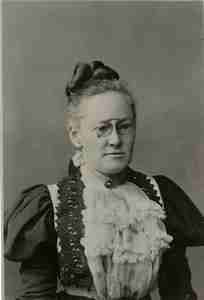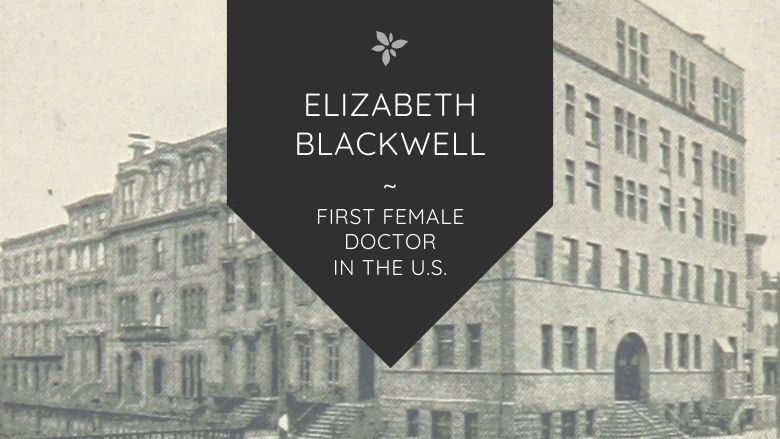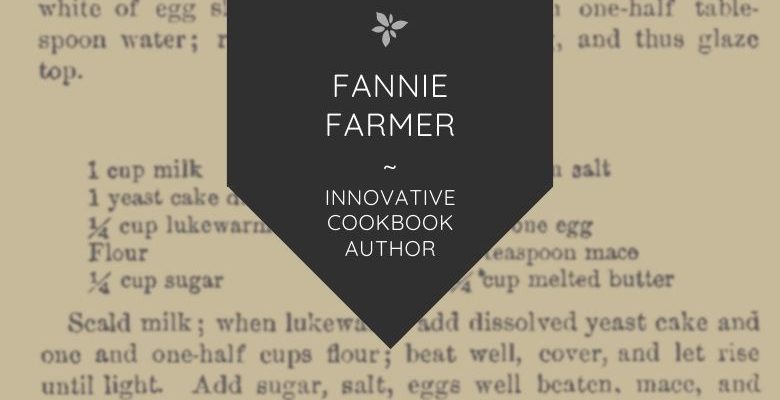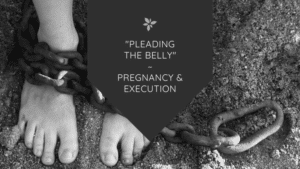Fannie Farmer was the author of The Boston Cooking-School Cookbook, the first cookbook to use strict standardized measurements. Called “the mother of level measurements”, Fannie was also a teacher and lecturer who helped to popularize a more scientific approach to cooking and housekeeping, and inspired doctors and nurses with her innovative teachings on convalescent diet and nutrition.

Correct measurements are absolutely necessary to insure the best results. Good judgment, with experience, has taught some to measure by sight; but the majority need definite guides.
Fannie Farmer
Fannie was born in 1857 in Boston to a mother and father who believed in education for women. Her family planned on sending her to college, but a stroke at the age of 16 left her paralyzed and forced her to stay at home with her parents instead.
To help support her family, Fannie took up cooking and housekeeping. Eventually she was able to walk again though she still had a limp. She decided to enroll in the Boston Cooking School at the age of 30.
The Boston Cooking School believed in a scientific approach to cooking and housekeeping. They taught not only how to cook, but also about nutrition, sanitation, chemical analysis, and household management. Fannie excelled in her classes, and upon graduation she took a post as assistant to the director. Only two years after she graduated, she was made principal.
In 1896, Fannie approached the publisher Little, Brown & Company with her book, The Boston Cooking-School Cookbook. They didn’t think it would do very well, so they only agreed to print a limited run of 3,000 books if Fannie would cover the costs.
The Boston Cooking-School Cookbook included not just recipes, but also housekeeping tips, instructions on cooking techniques and food preservation, nutritional information, and scientific explanations of the chemical reactions that occur in cooking and baking.
It is my wish that it may not only be looked upon as a compilation of tried and tested recipes, but that it may awaken an interest through its condensed scientific knowledge which will lead to deeper thought and broader study of what to eat.
Fannie Farmer
The book was an immediate success. It become a best-seller across the United States, selling over 4 million copies during Fannie’s lifetime.

Fannie continued as principal for 11 years at The Boston Cooking School before she left to found her own school, called Miss Farmer’s School of Cookery also in Boston. In addition to teaching, she traveled across the United States giving lectures. She began to focus on convalescent diet and nutrition, and was even invited to teach the subject to doctors and nurses at Harvard Medical School.
Fannie’s approach to convalescent cooking was innovative in its empathy and compassion. She emphasized the importance of appearance, taste, and presentation in food for sick people with poor appetites. In 1904, she wrote a book called Food and Cookery for the Sick and Convalescent, which is the book she thought she would be known for.
Men and women are certainly but children of an older growth, which fact is especially emphasized during times of sickness and suffering.
Fannie Farmer
Fannie gave lectures on cooking and nutrition until the final days of her life in 1913, though she suffered from several more strokes and had to speak from a wheelchair. The school she founded, Miss Farmer’s School of Cookery, stayed open until 1944. A revised version of her book, now known as Fannie Farmer’s Cookbook, is still in print today, over 100 years after its first printing.
Fannie Farmer’s 1896 Hot Cocoa Recipe
This recipe comes from Fannie Farmer’s Boston Cooking-School Cookbook.
Americans have been drinking chocolate even longer than we’ve been a country: the North American colonies were importing chocolate as early as the 17th century. During the Revolutionary War, chocolate was rationed to American armies because it was easily transportable without spoiling.
Though the Aztecs first drank chocolate with chili pepper, Europeans began experimenting with sugar and flavorings like vanilla, anise, cinnamon, and orange peel as soon as they discovered the drink.
This recipe is typical of the hot cocoa that Americans drank until solid eating chocolate was invented in the late 19th century.
This recipe, slightly modified from the original for the modern reader, would have been prepared for guests at any time of day. Fannie Farmer would have also used it to give medicine to the sick, to calm over-stimulated patients, and improve digestion.
For an authentic 19th-century experience, serve in a double-handled porcelain chocolate cup.
- Prep Time: 5 minutes
- Cook Time: 10 minutes
- Ready In: 15 minutes
- Servings: 4
Ingredients
- 3 tbsp cocoa
- 1 tsp salt
- 1/4 c sugar
- 4 c milk
- 3/4 c boiling water
- 3 tsp cooking brandy
Heat Milk
The original recipe instructs the reader to “Scald milk”, which isn’t necessary for pasteurized milk. Instead, heat it in a container in the microwave or in a separate saucepan on the stove.
Mix dry ingredients
In a saucepan, mix cocoa, sugar, and salt.
Combine
Slowly stir in boiling water until the mixture becomes a smooth paste. Add remaining water and boil five minutes. Pour into scalded milk. Optional – add brandy.
Froth
Beat two minutes, using egg-beater, when froth will form, preventing scum, which is so unsightly; this is known as milling.
Next, read about Clara Barton, Humanitarian and Founder of the American Red Cross, or Elizabeth Blackwell, M.D., America’s first female doctor!

References
- “Fannie Farmer.” Wikipedia, The Free Encyclopedia. Wikimedia Foundation, Inc. Accessed July 22, 2013.
- “Boston Cooking-School Cook Book.” Wikipedia, The Free Encyclopedia. Wikimedia Foundation, Inc. Accessed July 22, 2013.
- “Fannie Farmer opens cooking school.” History.com. n.d. Accessed July 22, 2013.
- “Farmer, Fannie Merritt.” Feeding America: The Historic American Cookbook Project. n.d. Accessed July 22, 2013.
- Farmer, Fannie. The Boston Cooking-School Cook Book. Boston: Little, Brown 1918 . Web.
Keri is a blogger and digital marketing professional who founded Amazing Women In History in 2011.






Thank you so much for sharing about Fannie Farmer. I have read so very little about her to this point I appreciate having more information. We just covered this time period in the class I teach and I look forward to adding this to our readings next year.